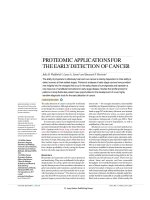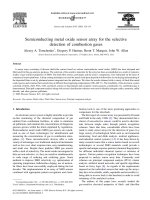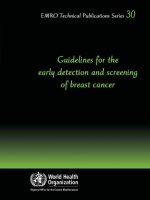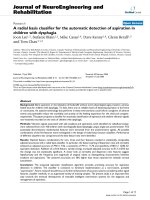Measuring telomere length for the early detection of precursor lesions of esophageal squamous cell carcinoma
Bạn đang xem bản rút gọn của tài liệu. Xem và tải ngay bản đầy đủ của tài liệu tại đây (300.44 KB, 8 trang )
Lin et al. BMC Cancer 2013, 13:578
/>
RESEARCH ARTICLE
Open Access
Measuring telomere length for the early
detection of precursor lesions of esophageal
squamous cell carcinoma
Shih-Wen Lin1*, Christian C Abnet1, Neal D Freedman1, Gwen Murphy1, Rosana Risques2, Donna Prunkard2,
Peter Rabinovitch2, Qin-Jing Pan3, Mark J Roth4, Guo-Qing Wang3, Wen-Qiang Wei3, Ning Lu3, Philip R Taylor1,
You-Lin Qiao3* and Sanford M Dawsey1
Abstract
Background: Esophageal cancer is the sixth leading cause of cancer death worldwide; current early detection
screening tests are inadequate. Esophageal balloon cytology successfully retrieves exfoliated and scraped superficial
esophageal epithelial cells, but cytologic reading of these cells has poor sensitivity and specificity for detecting
esophageal squamous dysplasia (ESD), the precursor lesion of esophageal squamous cell carcinoma (ESCC).
Measuring telomere length, a marker for chromosomal instability, may improve the utility of balloon cytology for
detecting ESD and early ESCC.
Methods: We examined balloon cytology specimens from 89 asymptomatic cases of ESD (37 low-grade and 52
high-grade) and 92 age- and sex-matched normal controls from an esophageal cancer early detection screening study.
All subjects also underwent endoscopy and biopsy, and ESD was diagnosed histopathologically. DNA was extracted from
the balloon cytology cells, and telomere length was measured by quantitative PCR. A receiver operating characteristic
(ROC) curve was plotted for telomere length as a diagnostic marker for high-grade dysplasia.
Results: Telomere lengths were comparable among the low- and high-grade dysplasia cases and controls, with means
of 0.96, 0.96, and 0.92, respectively. The area under the ROC curve was 0.55 for telomere length as a diagnostic marker
for high-grade dysplasia. Further adjustment for subject characteristics, including sex, age, smoking, drinking, hypertension, and body mass index did not improve the use of telomere length as a marker for ESD.
Conclusions: Telomere length of esophageal balloon cytology cells was not associated with ESCC precursor lesions.
Therefore, telomere length shows little promise as an early detection marker for ESCC in esophageal balloon samples.
Keywords: Esophageal squamous cell carcinoma, Esophageal squamous dysplasia, Early detection, Screening, Balloon
cytology, Telomeres
Background
Esophageal cancer is the 6th leading cause of cancer
death worldwide and was estimated to have killed 406,800
people in 2008 [1]. Over 80% of esophageal cancer cases
and deaths occur in developing countries [1], and in these
areas, 90% of these cases are esophageal squamous cell
* Correspondence: ;
1
Division of Cancer Epidemiology & Genetics, National Cancer Institute, 9609
Medical Center Drive, Bethesda, MD 20892, USA
3
Cancer Institute, Chinese Academy of Medical Sciences, P. O. Box 2258,
Beijing 100021, People’s Republic of China
Full list of author information is available at the end of the article
carcinoma (ESCC) [1,2]. Esophageal cancers can be successfully treated if diagnosed early [3], but tumors are usually asymptomatic until they reach an advanced stage,
when they are much more difficult to cure. In the United
States, the overall 5-year relative survival rate for esophageal cancer is 19% [4], but in low-resource populations, in
which most esophageal cancer cases occur, the survival
rate may be as low as 3% [5]. Asymptomatic patients with
precursor lesions can be treated to prevent progression to
invasive tumors and death [6,7], but current screening
tests for precursor lesions are inadequate.
© 2013 Lin et al.; licensee BioMed Central Ltd. This is an Open Access article distributed under the terms of the Creative
Commons Attribution License ( which permits unrestricted use, distribution, and
reproduction in any medium, provided the original work is properly cited. The Creative Commons Public Domain Dedication
waiver ( applies to the data made available in this article, unless otherwise
stated.
Lin et al. BMC Cancer 2013, 13:578
/>
One of the highest risk regions for ESCC is in northcentral China, which includes the county of Linxian [8].
Previous studies by our group in this region have shown
that esophageal squamous dysplasia (ESD) is the clinically relevant precursor lesion of ESCC [9,10] and that
ESD can be accurately identified with the use of Lugol’s
iodine staining during endoscopy and confirmed with
biopsy [11]. However, endoscopy is time-consuming, invasive, and also requires specially trained personnel and
equipment to perform the examination, take biopsies,
and make appropriate pathologic diagnoses, so frequent
endoscopy for ESCC early detection screening in highrisk asymptomatic populations in underdeveloped settings with inadequate health resources remains a major
challenge [12].
Balloon cytology, a simple and inexpensive method
of retrieving esophageal cells, has been commonly used
in China for diagnosing patients with dysphagia or for
screening asymptomatic, high-risk populations for esophageal cancer [13]. In our previous studies, balloon cytology
using traditional cytologic examination had poor sensitivity and specificity for detecting ESD [14,15]. Thus, if a biomarker of esophageal disease that could be measured in
the balloon cytology cells could improve the sensitivity
and specificity of this cell collection technique for detecting ESD, it might make an important public health impact.
A validated early detection marker for ESD might also
eventually serve as a target for the future development of
inexpensive and rapid point-of-care molecular diagnostics
that could be used to augment balloon cytology in
resource-limited locations.
One hypothesized biomarker of neoplastic disease is
telomere length. Telomeres are regions of repetitive nucleotide sequence at the ends of chromosomes that protect
these ends from deterioration or fusion with neighboring
chromosomes [16]. Chromosome replication during cell
division results in telomere shortening. In the absence of
the telomerase reverse transcriptase enzyme, which maintains telomere length, cells undergo replicative senescence.
Thus, telomere length and the restriction of telomerase
activity may play important roles in the prevention of
uncontrolled cell division [17]. Telomere dysfunction or
shortening is a common, and often early, genetic alteration
acquired in a cancer [18]. Telomere length may serve as a
marker of both chromosomal instability and cancer development [19].
Previous work has found that telomere length is associated with cancer incidence and mortality [20]. Several
studies have examined the association between telomere
length and neoplastic progression, including studies of
biliary tract [21], colon [22-24], lung [25], and prostate
[26] cancer. Telomere length abnormalities have been
found to occur early in the initiation of epithelial carcinogenesis and may be an initiating event in many human
Page 2 of 8
epithelial cancers [27]. Shortened telomeres have been
found in cancer cells isolated from paraffin-embedded sections of ESCC tumor biopsies [28]. Furthermore, patients
who underwent esophageal resection as a result of ESCC
had shorter telomeres in their tumors relative to their
nearby non-neoplastic esophageal epithelial cells. However, it is particularly important to note that both the
tumor and the nearby non-neoplastic esophageal epithelial
cell types from cancer patients had shorter telomere
lengths than the cells collected from non-cancer individuals with normal esophageal epithelium, suggesting a
telomere-shortened epithelial field in the cancer patients
[29]. In addition to studies in ESCC, some other studies
have focused on individuals with Barrett’s esophagus, who
are at increased risk of esophageal adenocarcinoma,
another type of esophageal cancer. Tissue biopsies of
Barrett’s esophagus, the premalignant condition that is
linked to the development of esophageal adenocarcinoma,
have displayed shortened telomeres [30], and shorter blood
leukocyte telomere length among Barrett’s esophagus patients has been associated with an increased risk of future
esophageal adenocarcinoma [31]. Another study suggested
that chromosome-specific telomere length in blood cells
may be related to esophageal cancer [32].
Given the evidence that ESCC tumor cells may have
shortened telomeres and given that non-malignant esophageal epithelial cells from cancer patients have shorter
telomeres compared with normal esophageal cells from
non-cancer patients (suggesting a telomere-shortened
epithelial field in the cancer patients) [29], we aimed to
examine the telomere length of DNA extracted from
balloon cytology-collected esophageal cells as a potential
early detection biomarker for ESD, the histologic precursor of ESCC. These cells were collected from high-risk
asymptomatic patients with a spectrum of concurrent
endoscopic biopsy-proven ESD.
Methods
Patient population
The participants were recruited from a commune in
Linxian, China, in the spring of 2002, as part of a cancer
screening study using esophageal balloon cytology (Cytology Sampling Study 2), as previously described [15].
Briefly, the study targeted healthy residents aged 50- to
64-years old, although approximately 10% of the 720
participating individuals fell outside of that age range.
Individuals who had any signs or symptoms of upper
gastrointestinal (GI) cancer (dysphagia, hematemesis) or
other chronic diseases (liver cirrhosis, congestive heart
failure, unstable angina) were excluded from the study.
All subjects completed a written informed consent and
a short questionnaire and physical exam prior to the
esophageal cancer screening procedures. The study was
approved by the Institutional Review Boards of the Cancer
Lin et al. BMC Cancer 2013, 13:578
/>
Institute of the Chinese Academy of Medical Sciences and
the U.S. National Cancer Institute.
Balloon cytology
All subjects fasted overnight prior to the balloon cytology exam and were randomly assigned one of two
esophageal balloon cytology retrieval devices, as previously described [15]. The samples used in the present
study were all collected using an expandable balloon with
a plastic mesh covering (Cytomesh Esophageal Cytology
Device, Wilson-Cook Medical, Inc., Winston-Salem, North
Carolina, USA). The patient was given 2 ml of a 2% lidocaine slurry by mouth for local anesthesia, and the balloon
was inserted into the back of the throat and swallowed.
Once in the stomach, the balloon and mesh covering were
expanded with 7–10 mL of air and gradually withdrawn
through the esophagus. The balloon, along with its collected cells from the stomach, the full length of the
esophagus, and the oral cavity, was cut using sterile scissors and placed in 40 mL of saline in a 50-mL centrifuge
tube, shaken, and transferred on ice to the central processing laboratory. The sample was then vortexed to remove
adherent cells from the balloon. After the balloon was removed, the remaining sample was centrifuged at 1500
RPM for 5 minutes; the pellet that formed was resuspended in 1 mL of saline and snap frozen in liquid nitrogen and stored at −80°C until DNA extraction.
Endoscopic examination
Two weeks after the balloon cytology, all subjects underwent endoscopy to examine the esophagus and stomach.
After fasting overnight, the subjects were given 5 mL of
a 1% lidocaine slurry by mouth for local anesthesia 2–
5 minutes prior to endoscopy, which was performed
using a Pentax EG-2930 or EG-2731 videoendoscope
(Pentax Medical Company, Montvale, New Jersey, USA).
Glycerin-free Lugol’s iodine solution was sprayed from
the gastroesophageal junction to the upper esophageal
sphincter. All visible lesions and Lugol’s-unstained areas
in the esophagus and at least 1 normally stained midesophageal site were biopsied. The endoscopic biopsy slides
were read using criteria previously described [33,34].
Page 3 of 8
dysplasia as their worst biopsy diagnosis: 38 cases of mild
dysplasia, 38 cases of moderate dysplasia, and 17 cases of
severe dysplasia. We then selected 94 normal controls who
were matched to the squamous dysplasia cases based on
age (within 5 years) and sex. In addition, we selected 50
cases of esophagitis that were matched based on age
(within 5 years) and sex to the already selected controls.
Telomere length measurement
Telomere length of the DNA samples was measured by
quantitative PCR [31,35]. Each sample (200 ng) was
amplified for telomeric DNA and for 36B4, a single-copy
control gene, which was used as an internal control to
normalize the starting amount of DNA. PCR reactions
were set up with a Qiagility pipetting robot and were
performed in a Rotor Gene Q (Qiagen, Valencia, CA).
Samples were run in batches of 24, with each batch including 2 or 3 randomly inserted quality control samples,
which came from a pool of 5 endoscopically normal subjects not selected for this study. Two additional controls
were used for normalization between experiments. Periodic reproducibility experiments were performed to confirm adequate normalization. All samples, standards, and
controls were run in triplicate, and the median value was
used for the analyses. A standard curve was used to transform the cycle threshold into nanograms of DNA. The
amount of telomeric DNA (T) was divided by the amount
of single-copy control gene DNA (S), producing a relative
measurement of the telomere length (T/S ratio). The coefficient of variation for the quantitative PCR across all
batches was 8.5%.
Covariates
The following baseline characteristics of the subjects
were included in the analysis: age in years, body mass
index (BMI, kg/m2) from measured height and weight,
tobacco smoking (ever versus never), alcohol drinking
(any in the past 12 months versus none), and hypertension (measured systolic blood pressure over 140 mm Hg
or diastolic blood pressure over 90 mm Hg).
Statistical analysis
DNA extraction
The Gentra Puregene Cell kit (Qiagen, Valencia, CA) was
used according to the manufacturer’s instructions to extract the DNA from 300 ul of the cell suspension. The
DNA quality and quantity was checked using the 260:280
ratio, Nanodrop, and Picogreen.
Study design
We used a nested case–control design and selected subjects who had undergone both balloon cytology and endoscopy. We selected all of the subjects who had squamous
Some of the selected subjects did not have sufficient
DNA for telomere length measurement, so in our final
analysis we had data available from 50 cases of esophagitis,
37 cases of mild dysplasia, 37 cases of moderate dysplasia,
15 cases of severe dysplasia, and 92 normal controls. Lowgrade dysplasia was synonymous with mild dysplasia,
while high-grade dysplasia combined the 37 cases of moderate dysplasia and 15 cases of severe dysplasia into one
category. Given the number of cases and controls, we had
80% power to detect a statistically significant difference of
0.10 in telomere length between the groups.
Lin et al. BMC Cancer 2013, 13:578
/>
Page 4 of 8
Table 1 Distribution of selected characteristics for the Cytology Sampling Study 2 in Linxian, China
Characteristics
Normal
(n = 92)
Esophagitis
(N = 50)
Mild dysplasia
(N = 37)
Moderate dysplasia
(N = 37)
Severe dysplasia
(N = 15)
Males, N (%)
43 (47)
12 (24)
17 (46)
16 (43)
7 (47)
Age, median years (Q1-Q3)
54 (51–57)
53 (51–57)
54 (51–58)
55 (53–57)
55 (52–57)
23.5 (21.5-24.8)
23.2 (21.8-25.4)
23.1 (20.8-25.2)
22.7 (20.4-24.8)
24.5 (22.5-27.2)
Ever smoke cigarettes, N (%)
28 (30)
11 (22)
10 (27)
11 (30)
5 (33)
Drink alcohol, any, N (%)
11 (12)
2 (4)
2 (5)
2 (5)
1 (7)
BMI, median (Q1-Q3)
Hypertension, yes, N (%)
Telomere lengtha, mean (SD)
Telomere lengtha, median (Q1-Q3)a
64 (68)
34 (68)
30 (81)
27 (73)
11 (73)
0.92 (0.17)
0.90 (0.16)
0.96 (0.18)
0.95 (0.17)
0.97 (0.24)
0.92 (0.78-1.05)
0.88 (0.80-1.00)
0.93 (0.84-1.06)
0.94 (0.82-1.09)
0.93 (0.85-0.98)
a
Calculated as telomeric DNA (T) divided by amount of single-copy control gene DNA (S) to produce the relative measurement of telomere length (T/S ratio).
Abbreviations: SD, standard deviation; Q1, first quartile; Q3, third quartile; BMI, body mass index.
Telomere length among the normal controls was assessed for normality, and we found no evidence for deviation from a normal distribution. Telomere length was
treated as a continuous variable and as quartiles based on
the distribution in controls. The Wilcoxon exact test and
the analysis of variance (ANOVA) were used to compare
telomere length by subject characteristics. A receiver operating characteristic (ROC) curve was plotted for the use
of telomere length as a diagnostic marker for high-grade
dysplasia. The association between telomere length (scaled
by half of the interquartile range or as quartiles) and the
worst biopsy diagnosis was assessed using unconditional
logistic regression models. Adjusted models included age,
sex, BMI, tobacco smoking, alcohol use, and hypertension.
All tests were two-sided, and p-values <0.05 and confidence intervals (CI) that did not overlap with 1.00 were
considered statistically significant. SAS 9.2 was used for
statistical analyses, and GraphPad Prism 5 was used for
the ROC analysis.
Results
The characteristics for the subjects chosen for this study
are shown in Table 1. More women than men were selected. Compared with the other groups, the severe dysplasia cases had a slightly higher BMI and were more
likely to smoke tobacco. In this population, those who
reported smoking tobacco were almost exclusively male.
Alcohol intake was relatively rare in this population. The
mean telomere lengths among the normal controls (0.92)
and the esophagitis (0.90) and mild (0.96), moderate (0.95),
and severe dysplasia (0.97) cases were similar (p = 0.542).
For further analyses, we dichotomized the dysplasia cases
by categorizing the mild dysplasia cases as low-grade dysplasia and combining the moderate and severe dysplasia
cases into one category of high-grade dysplasia (this combined high-grade dysplasia group had a mean telomere
length of 0.96, 95% CI 0.90-1.01).
Table 2 shows the distribution of telomere lengths among
the controls by select subject characteristics. Telomere
length did not significantly differ across any of these subject
characteristics.
Figure 1 shows the ROC curve for the use of telomere
length as a diagnostic marker for high-grade dysplasia. The
area under the curve was 0.55, suggesting that telomere
length of esophageal cells collected by balloon cytology is a
poor marker of the presence of high-grade dysplasia.
We further assessed the association between telomere
length and worst biopsy diagnosis, as shown in Table 3.
Table 2 Telomere lengtha by selected subject characteristics
among the normal controls
Characteristics
N
Mean
SD
Q1
Median
Q3
Males
43
0.91
0.17
0.78
0.92
1.03
Females
49
0.94
0.18
0.79
0.94
1.06
<54 years
45
0.94
0.18
0.80
0.94
1.06
≥54 years
47
0.91
0.17
0.80
0.89
1.04
<18.5
2
0.89
-
0.83
0.89
0.95
p
Sex
0.51
Age
0.36
BMI
18.5 - <23
40
0.92
0.18
0.75
0.92
1.04
23 - <27.5
46
0.94
0.17
0.80
0.93
1.06
≥27.5
4
0.94
0.18
0.82
0.94
1.06
Ever
28
0.89
0.17
0.77
0.90
0.97
Never
64
0.94
0.18
0.79
0.95
1.06
Any
11
0.94
0.13
0.89
0.95
1.04
None
81
0.92
0.18
0.78
0.91
1.05
Yes
63
0.92
0.17
0.77
0.90
1.04
No
29
0.94
0.18
0.84
0.95
1.06
0.78
Smoke tobacco
0.21
Drink alcohol
0.65
Hypertension
a
0.36
Calculated as telomeric DNA (T) divided by amount of single-copy control gene
DNA (S) to produce the relative measurement of telomere length (T/S ratio).
Abbreviations: SD, standard deviation; Q1, first quartile; Q3, third quartile; BMI,
body mass index.
Lin et al. BMC Cancer 2013, 13:578
/>
Page 5 of 8
Figure 1 Receiver operating characteristic (ROC) curve plotted
for the use of telomere length as a diagnostic marker for
high-grade dysplasia (area under the curve = 0.55).
Telomere length, considered either as a continuous variable
or as quartiles, was not associated with esophagitis, lowgrade dysplasia, or high-grade dysplasia. Adjusting for multiple potential confounders did not change the estimates.
Table 4 shows the unconditional logistic regression
models, both crude and adjusted, for risk of high-grade
dysplasia by telomere length. Again, no associations were
observed.
Discussion
ESCC is generally diagnosed at a late stage and has a
very poor prognosis, so improving the methods of early
detection for these cancers is both urgent and of great
public health importance. We previously found that esophageal balloon cytology had low sensitivity and specificity
for detecting the high-grade dysplastic lesions that are
likely to progress to ESCC [14,15]. Telomere length abnormalities, which are linked to genomic stability and risk of
cancer [19], have been found in ESCC [28], epithelial precursor lesions of multiple cancers [27], and, most important for the current study, in the broader non-malignant
epithelial field from which squamous cell carcinomas of
the esophagus arise [29]. Thus, we aimed to examine
whether analysis of telomere length from esophageal balloon cytology samples could be used as an early detection
screening tool. However, in this study, we found that
telomere length of the esophageal cells collected by this
method was not associated with the presence of low- or
high-grade dysplasia in the patients, so the telomere length
of such cells could not be used to identify individuals with
esophageal precursor lesions who should subsequently
undergo endoscopy for confirmation and treatment or
follow-up of their lesions.
Most previous studies of telomere length in cancer have
measured telomeres in peripheral blood lymphocytes or
Table 3 Associations between telomere lengtha and worst biopsy diagnosis
Esophagitis
Low-grade dysplasiab
High-grade dysplasiac
Controls
Cases
OR (95% CI)
Cases
OR (95% CI)
Cases
OR (95% CI)
92
50
0.90 (0.68-1.18)
37
1.14 (0.86-1.51)
52
1.14 (0.89-1.46)
<0.784
23
10
ref
4
ref
10
ref
0.784 - <0.925
23
24
2.40 (0.94-6.13)
14
3.50 (1.00-12.25)
14
1.40 (0.52-3.79)
0.925 - <1.047
23
5
0.50 (0.15-1.69)
9
2.25 (0.61-8.36)
13
1.30 (0.48-3.56)
≥1.047
23
11
1.10 (0.39-3.09)
10
2.50 (0.68-9.13)
15
1.50 (0.56-4.03)
Unadjusted
Continuousd
Quartiles
p-trend
0.031
0.224
0.870
Adjustede
Continuousd
92
50
0.91 (0.68-1.21)
<0.784
23
10
ref
0.784 - <0.925
23
24
2.46 (0.89-6.80)
0.925 - <1.047
23
5
0.59 (0.16-2.13)
≥1.047
23
11
1.08 (0.36-3.28)
37
1.16 (0.87-1.54)
52
1.20 (0.92-1.56)
4
ref
10
ref
14
4.80 (1.26-18.35)
14
1.51 (0.54-4.24)
9
3.07 (0.78-12.06)
13
1.50 (0.52-4.27)
10
3.05 (0.80-11.66)
15
1.83 (0.65-5.12)
Quartiles
p-trend
a
0.060
0.107
0.713
Calculated as telomeric DNA (T) divided by amount of single-copy control gene DNA (S) to produce the relative measurement of telomere length (T/S ratio).
b
Low-grade dysplasia category includes mild dysplasia cases.
c
High-grade dysplasia category includes moderate and severe dysplasia cases.
d
Continuous telomere length scaled by half the interquartile range based on the distribution among the normal controls.
e
Models adjusted for age, sex, BMI, tobacco smoking, alcohol drinking, and hypertension.
Abbreviations: OR, odds ratio; CI, confidence interval; BMI, body mass index.
Lin et al. BMC Cancer 2013, 13:578
/>
Page 6 of 8
Table 4 Association between telomere lengtha and
high-grade dysplasia compared with all other diagnoses
Controls and all
other diagnosesb
High-grade
dysplasiac
Cases
OR (95% CI)
179
52
1.14 (0.91-1.43)
<0.784
37
10
ref
0.784 - <0.925
61
14
0.85 (0.34-2.11)
Unadjusted
Continuousd
Quartiles
0.925 - <1.047
37
13
1.30 (0.51-3.34)
≥1.047
44
15
1.26 (0.51-3.14)
p-trend
0.728
Adjustede
Continuousd
179
52
1.17 (0.93-1.37)
<0.784
37
10
ref
0.784 - <0.925
61
14
0.93 (0.36-2.37)
Quartiles
0.925 - <1.047
37
13
1.43 (0.55-3.76)
≥1.047
44
15
1.39 (0.55-3.54)
p-trend
0.684
a
Calculated as telomeric DNA (T) divided by amount of single-copy control
gene DNA (S) to produce the relative measurement of telomere length
(T/S ratio).
b
Category includes normal controls, esophagitis cases, and mild dysplasia cases.
c
High-grade dysplasia category includes moderate and severe dysplasia cases.
d
Continuous telomere length scaled by half the interquartile range based on
the distribution among the normal controls.
e
Models adjusted for age, sex, BMI, tobacco smoking, alcohol drinking,
and hypertension.
Abbreviations: OR, odds ratio; CI, confidence interval; BMI, body mass index.
in cells isolated from biopsied tumors or other lesions
[28-30,36,37]. By contrast, our study measured telomere
length in cells collected by esophageal balloon cytology,
which was a mixture of cells from the full length of the
esophagus as well as some cells collected from the stomach and the oral cavity. Previously, non-neoplastic esophageal epithelial cells from ESCC patients were reported to
have shorter mean telomere length than esophageal cells
from non-cancer patients [29], suggesting the presence of
a telomere-shortened epithelial field that could potentially
be detected using balloon cytology or other analogous
methods. In the current study, however, we could detect
no difference in mean telomere length between participants with and without ESD. Differences between the
results of our study and the previous one may reflect
differences in methods, actual differences in telomere
lengths in “normal” cells adjacent to ESCC and “normal”
cells adjacent to ESD, and/or chance. In any case, an effective early detection biomarker in balloon cytology cell samples must be present in a broad carcinogen-altered field
and must be reproducible. Thus, while we previously
showed the feasibility of screening for telomerase activity in
samples collected by esophageal balloon cytology [38], we
demonstrate here that telomere length itself cannot serve
as an early detection marker for ESD in these samples.
Our study had several limitations. We had a limited
number of cases with low-grade and high-grade dysplasia.
Moreover, we extracted DNA from cells collected by esophageal balloon cytology samplers, so any focal (non-field)
differences in telomere length would have had to be large
to be detected. Future work may examine telomere length
in peripheral blood lymphocytes collected from individuals
with endoscopy and biopsy-diagnosed esophageal precursor
lesions.
However, our study also had several strengths, including following many of the guidelines that facilitate the
development of biomarker-based screening tools suitable
for early detection of cancer [39]. We used samples from
a well-characterized patient population, and we included
asymptomatic and apparently healthy subjects with a full
spectrum of esophageal health, from normal control subjects through esophagitis and mild, moderate, and severe
dysplasia. All of the subjects underwent the gold standard
exam for determining esophageal health (endoscopy with
Lugol’s staining and biopsy). In addition, the telomere
length assay used in this study, which had a low coefficient
of variation, used small amounts of DNA in a highthroughput assay and had been used in a number of previous studies of cancers in the gastrointestinal tract [23,40],
including those conducted in Barrett’s esophagus and
esophageal adenocarcinoma patients [31].
This is the first study to evaluate telomere length measured in esophageal balloon cytology samples as an early
detection marker for esophageal precursor lesions.
Conclusions
In conclusion, we observed no associations between telomere length in these samples and risk of low- or highgrade dysplasia, so our study provides little support for
this approach.
Abbreviations
ESD: Esophageal squamous dysplasia; ESCC: Esophageal squamous cell
carcinoma; ROC: Receiver operating characteristic; GI: Gastrointestinal;
BMI: Body mass index; ANOVA: Analysis of variance; CI: Confidence intervals.
Competing interests
The authors declare that they have no competing interests.
Authors’ contributions
SWL analyzed the data and wrote the manuscript. SWL, CCA, NDF, and SMD
designed the study and interpreted the data. GM provided helpful discussion
and critical reading of the manuscript. RR, DP, and PR conducted the
laboratory assays. QJP, MJR, GQW, WQW, NL, PRT, and YLQ designed the
sample collection and conducted the field work. All authors read and
approved the final manuscript.
Acknowledgements
This study was supported by National Cancer Institute contract N01-SC-91019
with the Cancer Institute of the Chinese Academy of Medical Sciences and by
Lin et al. BMC Cancer 2013, 13:578
/>
Page 7 of 8
the Intramural Research Program of the Division of Cancer Epidemiology and
Genetics of the National Cancer Institute, NIH.
16.
Author details
1
Division of Cancer Epidemiology & Genetics, National Cancer Institute, 9609
Medical Center Drive, Bethesda, MD 20892, USA. 2Department of Pathology,
University of Washington, 1959 NE Pacific Ave., Seattle, WA 98195, USA.
3
Cancer Institute, Chinese Academy of Medical Sciences, P. O. Box 2258,
Beijing 100021, People’s Republic of China. 4Laboratory of Pathology, Center
for Cancer Research, National Cancer Institute, Building 10, Bethesda, MD
20892, USA.
17.
18.
19.
Received: 9 October 2013 Accepted: 27 November 2013
Published: 5 December 2013
References
1. Jemal A, Bray F, Center MM, Ferlay J, Ward E, Forman D: Global cancer
statistics. CA Cancer J Clin 2011, 61(2):69–90.
2. Islami F, Kamangar F, Aghcheli K, Fahimi S, Semnani S, Taghavi N, Marjani HA,
Merat S, Nasseri-Moghaddam S, Pourshams A, et al: Epidemiologic features of
upper gastrointestinal tract cancers in Northeastern Iran. Br J Cancer 2004,
90(7):1402–1406.
3. Wang GQ, Jiao GG, Chang FB, Fang WH, Song JX, Lu N, Lin DM, Xie YQ,
Yang L: Long-term results of operation for 420 patients with early
squamous cell esophageal carcinoma discovered by screening.
Ann Thorac Surg 2004, 77(5):1740–1744.
4. Siegel R, Naishadham D, Jemal A: Cancer statistics, 2012. CA Cancer J Clin
2012, 62(1):10–29.
5. Aghcheli K, Marjani HA, Nasrollahzadeh D, Islami F, Shakeri R, Sotoudeh M,
Abedi-Ardekani B, Ghavamnasiri MR, Razaei E, Khalilipour E, et al: Prognostic
factors for esophageal squamous cell carcinoma–a population-based
study in Golestan Province, Iran, a high incidence area. PLoS ONE 2011,
6(7):e22152.
6. Inoue H, Minami H, Kaga M, Sato Y, Kudo SE: Endoscopic mucosal resection
and endoscopic submucosal dissection for esophageal dysplasia and
carcinoma. Gastrointest Endosc Clin N Am 2010, 20(1):25–34. v-vi.
7. Bergman JJ, Zhang YM, He S, Weusten B, Xue L, Fleischer DE, Lu N, Dawsey SM,
Wang GQ: Outcomes from a prospective trial of endoscopic radiofrequency
ablation of early squamous cell neoplasia of the esophagus.
Gastrointest Endosc 2011, 74(6):1181–1190.
8. Tran GD, Sun X-D, Abnet CC, Fan J-H, Dawsey SM, Dong Z-W, Mark SD,
Qiao Y-L, Taylor PR: Prospective study of risk factors for esophageal and
gastric cancers in the Linxian general population trial cohort in China.
Int J Cancer 2005, 113(3):456–463.
9. Wang G-Q, Abnet CC, Shen Q, Lewin KJ, Sun X-D, Roth MJ, Qiao Y-L,
Mark SD, Dong Z-W, Taylor PR, et al: Histological precursors of oesophageal
squamous cell carcinoma: results from a 13 year prospective follow up
study in a high risk population. Gut 2005, 54(2):187–192.
10. Dawsey SM, Lewin KJ, Wang GQ, Liu FS, Nieberg RK, Yu Y, Li JY, Blot WJ,
Li B, Taylor PR: Squamous esophageal histology and subsequent risk of
squamous cell carcinoma of the esophagus. A prospective follow-up
study from Linxian, China. Cancer 1994, 74(6):1686–1692.
11. Dawsey SM, Fleischer DE, Wang GQ, Zhou B, Kidwell JA, Lu N, Lewin KJ,
Roth MJ, Tio TL, Taylor PR: Mucosal iodine staining improves endoscopic
visualization of squamous dysplasia and squamous cell carcinoma of the
esophagus in Linxian. China. Cancer 1998, 83(2):220–231.
12. Yang J, Wei WQ, Niu J, Liu ZC, Yang CX, Qiao YL: Cost-benefit analysis of
esophageal cancer endoscopic screening in high-risk areas of China.
World J Gastroenterol 2012, 18(20):2493–2501.
13. Dawsey SM, Shen Q, Nieberg RK, Liu SF, English SA, Cao J, Zhou B, Wang GQ,
Lewin KJ, Liu FS, et al: Studies of esophageal balloon cytology in Linxian.
China. Cancer Epidemiol Biomarkers Prev 1997, 6(2):121–130.
14. Roth MJ, Liu SF, Dawsey SM, Zhou B, Copeland C, Wang GQ, Solomon D,
Baker SG, Giffen CA, Taylor PR: Cytologic detection of esophageal
squamous cell carcinoma and precursor lesions using balloon and
sponge samplers in asymptomatic adults in Linxian. China. Cancer 1997,
80(11):2047–2059.
15. Pan QJ, Roth MJ, Guo HQ, Kochman ML, Wang GQ, Henry M, Wei WQ,
Giffen CA, Lu N, Abnet CC, et al: Cytologic detection of esophageal
squamous cell carcinoma and its precursor lesions using balloon
20.
21.
22.
23.
24.
25.
26.
27.
28.
29.
30.
31.
32.
33.
34.
35.
samplers and liquid-based cytology in asymptomatic adults in Llinxian.
China. Acta Cytol 2008, 52(1):14–23.
Blackburn EH: Structure and function of telomeres. Nature 1991,
350(6319):569–573.
Pereira B, Ferreira MG: Sowing the seeds of cancer: telomeres and ageassociated tumorigenesis. Curr Opin Oncol 2013, 25(1):93–98. doi:10.1097/
CCO.1090b1013e32835b36358.
Raynaud CM, Sabatier L, Philipot O, Olaussen KA, Soria J-C: Telomere length,
telomeric proteins and genomic instability during the multistep
carcinogenic process. Critical reviews in oncology/hematology 2008,
66(2):99–117.
Bailey SM, Murnane JP: Telomeres, chromosome instability and cancer.
Nucleic Acids Res 2006, 34(8):2408–2417.
Willeit P, Willeit J, Mayr A, Weger S, Oberhollenzer F, Brandstatter A,
Kronenberg F, Kiechl S: Telomere length and risk of incident cancer and
cancer mortality. JAMA 2010, 304(1):69–75.
Hansel DE, Meeker AK, Hicks J, De Marzo AM, Lillemoe KD, Schulick R,
Hruban RH, Maitra A, Argani P: Telomere length variation in biliary tract
metaplasia, dysplasia, and carcinoma. Mod Pathol 2006, 19(6):772–779.
Plentz RR, Wiemann SU, Flemming P, Meier PN, Kubicka S, Kreipe H,
Manns MP, Rudolph KL: Telomere shortening of epithelial cells
characterises the adenoma-carcinoma transition of human colorectal
cancer. Gut 2003, 52(9):1304–1307.
O'Sullivan J, Risques RA, Mandelson MT, Chen L, Brentnall TA, Bronner MP,
MacMillan MP, Feng Z, Siebert JR, Potter JD, et al: Telomere length in the
colon declines with Age: a relation to colorectal cancer?
Cancer Epidemiol Biomarkers Prev 2006, 15(3):573–577.
Engelhardt M, Drullinsky P, Guillem J, Moore MA: Telomerase and telomere
length in the development and progression of premalignant lesions to
colorectal cancer. Clin Cancer Res 1997, 3(11):1931–1941.
Lantuejoul S, Soria JC, Morat L, Lorimier P, Moro-Sibilot D, Sabatier L,
Brambilla C, Brambilla E: Telomere shortening and telomerase reverse
transcriptase expression in preinvasive bronchial lesions. Clin Cancer Res
2005, 11(5):2074–2082.
Meeker AK, Hicks JL, Platz EA, March GE, Bennett CJ, Delannoy MJ,
De Marzo AM: Telomere shortening is an early somatic DNA alteration in
human prostate tumorigenesis. Cancer Res 2002, 62(22):6405–6409.
Meeker AK, Hicks JL, Iacobuzio-Donahue CA, Montgomery EA, Westra WH,
Chan TY, Ronnett BM, De Marzo AM: Telomere length abnormalities occur
early in the initiation of epithelial carcinogenesis. Clin Cancer Res 2004,
10(10):3317–3326.
Zheng Y-L, Hu N, Sun Q, Wang C, Taylor PR: Telomere attrition in cancer
cells and telomere length in tumor stroma cells predict chromosome
instability in esophageal squamous cell carcinoma: a genome-wide
analysis. Cancer Res 2009, 69(4):1604–1614.
Kammori M, Poon SS, Nakamura K, Izumiyama N, Ishikawa N, Kobayashi M,
Naomoto Y, Takubo K: Squamous cell carcinomas of the esophagus arise
from a telomere-shortened epithelial field. Int J Mol Med 2007,
20(6):793–799.
Finley JC, Reid BJ, Odze RD, Sanchez CA, Galipeau P, Li X, Self SG, Gollahon KA,
Blount PL, Rabinovitch PS: Chromosomal instability in Barrett’s esophagus is
related to telomere shortening. Cancer Epidemiol Biomarkers Prev 2006,
15(8):1451–1457.
Risques RA, Vaughan TL, Li X, Odze RD, Blount PL, Ayub K, Gallaher JL,
Reid BJ, Rabinovitch PS: Leukocyte telomere length predicts cancer risk
in Barrett’s esophagus. Cancer Epidemiol Biomarkers Prev 2007,
16(12):2649–2655.
Xing J, Ajani JA, Chen M, Izzo J, Lin J, Chen Z, Gu J, Wu X: Constitutive
short telomere length of chromosome 17p and 12q but not 11q and 2p
is associated with an increased risk for esophageal cancer.
Cancer Prevention Research 2009, 2(5):459–465.
Dawsey SM, Lewin KJ, Liu FS, Wang GQ, Shen Q: Esophageal morphology
from Linxian, China. Squamous histologic findings in 754 patients.
Cancer 1994, 73(8):2027–2037.
Wang GQ, Dawsey SM, Li JY, Taylor PR, Li B, Blot WJ, Weinstein WM, Liu FS,
Lewin KJ, Wang H: Effects of vitamin/mineral supplementation on the
prevalence of histological dysplasia and early cancer of the esophagus
and stomach: results from the General Population Trial in Linxian. China.
Cancer Epidemiol Biomarkers Prev 1994, 3(2):161–166.
Cawthon RM: Telomere measurement by quantitative PCR.
Nucleic Acids Res 2002, 30(10):e47.
Lin et al. BMC Cancer 2013, 13:578
/>
Page 8 of 8
36. Ma H, Zhou Z, Wei S, Liu Z, Pooley KA, Dunning AM, Svenson U, Roos G,
Hosgood HD III, Shen M, et al: Shortened telomere length is associated
with increased risk of cancer: a meta-analysis. PLoS ONE 2011, 6(6):e20466.
37. Wentzensen IM, Mirabello L, Pfeiffer RM, Savage SA: The association of telomere
length and cancer: a meta-analysis. Cancer Epidemiol Biomarkers Prev 2011,
20(6):1238–1250.
38. McGruder BM, Atha DH, Wang W, Huppi K, Wei W-Q, Abnet CC, Qiao Y-L,
Dawsey SM, Taylor PR, Jakupciak JP: Real-time telomerase assay of
less-invasively collected esophageal cell samples. Cancer Lett 2006,
244(1):91–100.
39. Pepe MS, Etzioni R, Feng Z, Potter JD, Thompson ML, Thornquist M, Winget M,
Yasui Y: Phases of biomarker development for early detection of cancer.
J Natl Cancer Inst 2001, 93(14):1054–1061.
40. Risques RA, Lai LA, Himmetoglu C, Ebaee A, Li L, Feng Z, Bronner MP,
Al-Lahham B, Kowdley KV, Lindor KD, et al: Ulcerative colitis–associated
colorectal cancer arises in a field of short telomeres, senescence, and
inflammation. Cancer Res 2011, 71(5):1669–1679.
doi:10.1186/1471-2407-13-578
Cite this article as: Lin et al.: Measuring telomere length for the early
detection of precursor lesions of esophageal squamous cell carcinoma.
BMC Cancer 2013 13:578.
Submit your next manuscript to BioMed Central
and take full advantage of:
• Convenient online submission
• Thorough peer review
• No space constraints or color figure charges
• Immediate publication on acceptance
• Inclusion in PubMed, CAS, Scopus and Google Scholar
• Research which is freely available for redistribution
Submit your manuscript at
www.biomedcentral.com/submit









